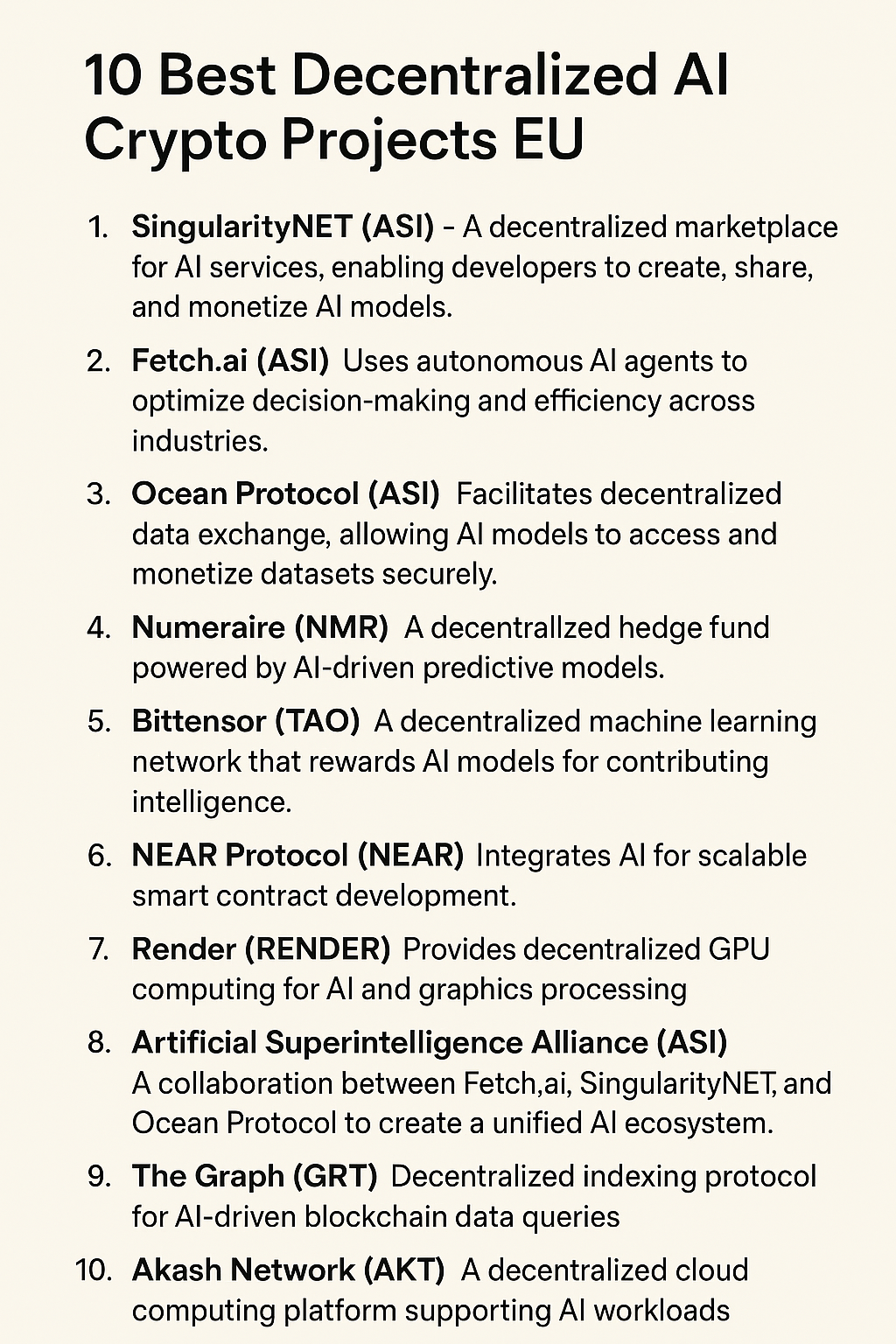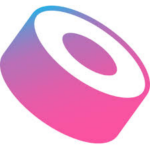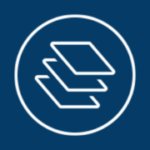In this article, i will discuss the top decentralized AI crypto projects shaking things up in Europe. These ventures mix blockchain security with smart machine learning to build open, private, and self-running tools.
Because the EU values fresh ideas and strong data rules, teams like SingularityNET, Fetch.ai, and Ocean Protocol are already changing how researchers and businesses work with AI outside traditional servers.
Key Point & Best decentralized AI crypto projects EU
| Project Name | Key Point |
|---|---|
| SingularityNET (ASI) | Decentralized AI marketplace enabling AI services to interact and monetize. |
| Fetch.ai (ASI) | Autonomous agents enabling real-time optimization and automation in AI. |
| Ocean Protocol (ASI) | Decentralized data exchange protocol for AI training and analytics. |
| Numeraire (NMR) | Uses AI models to crowdsource stock market predictions on the Numerai platform. |
| Bittensor (TAO) | Incentivized, decentralized network for machine learning model training. |
| NEAR Protocol (NEAR) | Scalable layer-1 blockchain ideal for AI app deployment with low fees. |
| Render (RENDER) | Decentralized GPU rendering network supporting AI, 3D, and visual tasks. |
| Artificial Superintelligence Alliance (ASI) | Joint force of SingularityNET, Fetch.ai, and Ocean for AI infrastructure. |
| The Graph (GRT) | Indexing protocol for querying blockchain data, crucial for AI data access. |
| Akash Network (AKT) | Decentralized cloud computing platform supporting AI workloads and hosting. |
1. SingularityNET (ASI)
SingularityNET runs a worldwide market where coders can build, share, and sell AI tools on a blockchain. The ledger keeps every transaction clear, so anyone can check who made what. Because the network talks between models, different AIs can team up on bigger tasks.
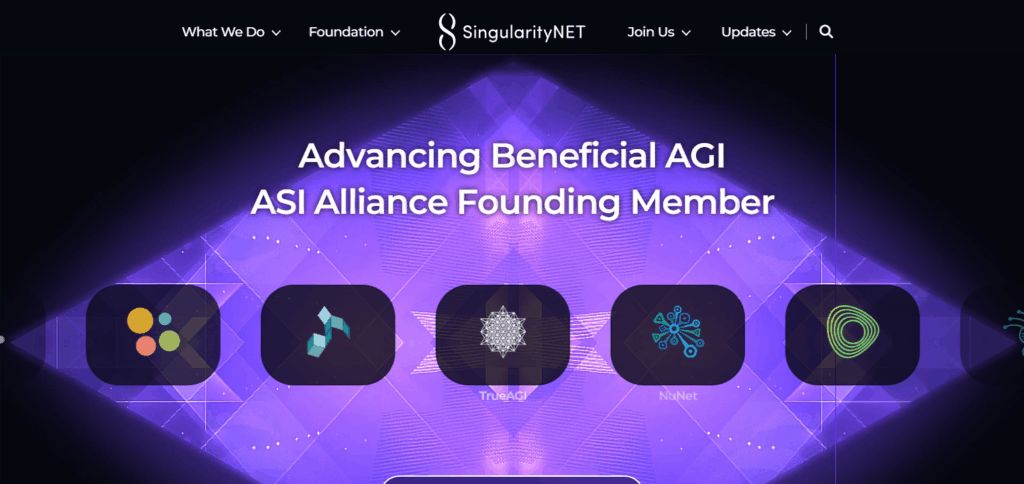
SingularityNET helped launch the Artificial Superintelligence Alliance (ASI) to link all decentralized AI groups.
New support for FET (ASI) tokens speeds operations and tightens security. Focused on fair and open AI, the project still sits at the front of the decentralized AI race.
2. Fetch.ai (ASI)
Fetch.ai gives each partner an autonomous digital agent that learns on its own and makes smarter choices. These agents now run finance, steer delivery routes, and manage parts of modern smart cities.

Accessing services uses ASI tokens, which skip the gas fees seen on some rival blockchains. The Agentverse toolbox lets developers plug their agents into any public ledger. Because there is no single boss, Fetch.ai keeps fees low and uptime high.
Teaming with SingularityNET and Ocean Protocol in the Artificial Superintelligence Alliance, the project pushes the next wave of distributed AI.
3. Ocean Protocol (ASI)
Ocean Protocol is a decentralized marketplace where data owners and AI experts can share and sell datasets without losing control. The system protects user privacy and meets legal rules while still letting machines mine quick insights.

Recently, Ocean folded its OCEAN tokens into the wider ASI ecosystem, which boosts its standing in the AI world. The protocol backs data tokenization, so users can swap files securely just like turning music into tradeable coins.
Work with Zero1 Labs further sharpens Ocean-powered models, giving them cleaner data and better results. As a charter member of the Artificial Superintelligence Alliance, the project helps build the backbone for future, decentralized smart systems.
4. Numeraire (NMR)
Numeraire runs like a crowd-tuned hedge fund, taking tips from AI models that try to guess market moves. Data scientists write algorithms, plug in historical patterns, and then lock up NMR tokens as proof their call is solid. If their forecast lands in the money, they earn tokens back plus bonuses; if it fails, some collateral vanishes.
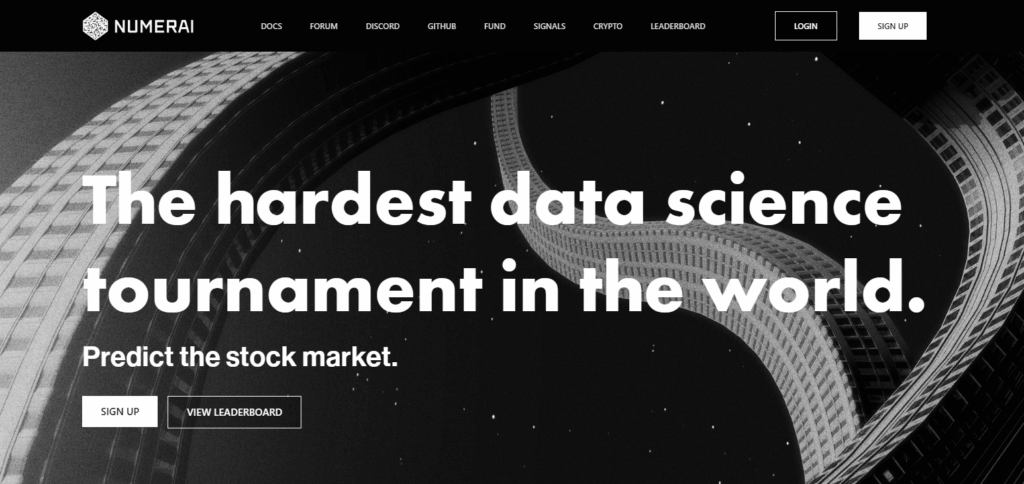
This staking dance keeps the system open, fair, and faster than old-school funds that hide prices behind closed doors. Merging machine learning with blockchain also squeezes out pointless fees and boosts prediction accuracy in real time.
Numeraire stands out in the booming DeFi scene, proving that crowds plus code can beat even top Wall Street quants. The team keeps tweaking the platform, so traders and analysts alike watch closely for the next big upgrade.
5. Bittensor (TAO)
Bittensor is a peer-to-peer network that pays AI models whenever they share useful knowledge. Instead of Proof-of-Work or Proof-of-Stake, it runs on a Proof-of-Intelligence (POI) system that double-checks each models output.
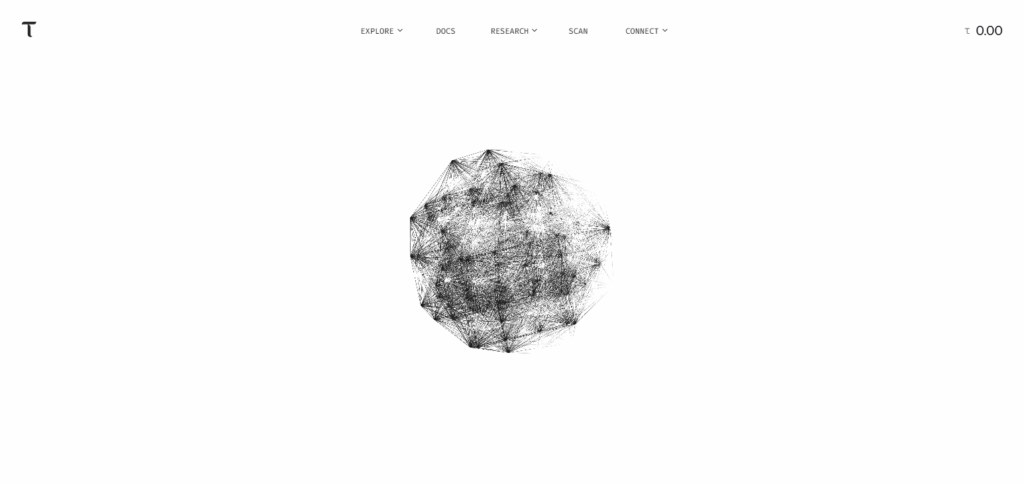
When many models work together, ideas spread faster, bugs get fixed sooner, and everyone learns. Bittensors subnet architecture let experts handle image recognition while others tackle language, keeping the whole chain nimble.
Because no single company owns the code or profits, the ecosystem stays open and fresh. With the TAO token, helpers get coins, traders find value, and Bittensor stays one of the top decentralized AI labs.
6. NEAR Protocol (NEAR)
NEAR Protocol adds AI-friendly tools so smart contracts can grow without slowdowns. Its modular, high-speed blockchain lets machine agents write rules, budget gas, and craft updates on the fly.

Thanks to shared shards, decisions clear in milliseconds, keeping users and bots satisfied. NEAR also guards secrets, letting private models talk to the chain without leaks.
By giving software the freedom to trade and innovate, NEAR is pushing the frontier of decentralized thought.
7. Render (RENDER)
Render Network lets artists and engineers tap into shared graphics chips spread all over the world. Owners of idle GPUs can rent their power, while AIs and 3D studios pay for fast, off-grid rendering.
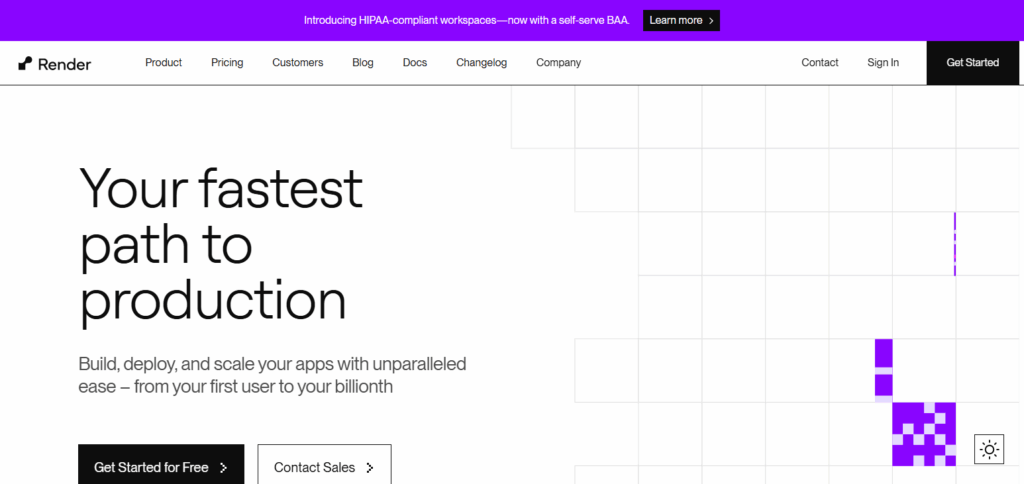
The system runs on the RNDR token, which moves funds between users and automatically matches supply with demand. Completed jobs are logged through a special proof-of-render proof so no one can cheat on results.
Because everything runs on a network rather than a single data farm, costs drop and access widens. Blockchains secure every deal, making Render a key piece of the growing decentralized AI toolbox.
8. Artificial Superintelligence Alliance (ASI)
The Artificial Superintelligence Alliance (ASI) brings together SingularityNET, Fetch.ai, and Ocean Protocol in a shared mission. Instead of building walled systems, the partners want an open backbone that lets AIs of all kinds talk and grow.

ASI backs ideas like symbolic reasoning, federated learning, and open research so engineers can build smarter futures together. Most payments and rewards inside this ecosystem flow through the shared ASI token, cutting red tape.
By wiring AI brains to blockchain, the alliance aims to speed discovery, lower costs, and guide the next wave of decentralized intelligence.
9. The Graph (GRT)
The Graph is a decentralized indexing tool that lets blockchains speak to artificial-intelligence apps. It organizes raw on-chain data so developers can grab only what they need. With its subgraph setup, AIs pull the right facts quickly, speeding up smarter choices.
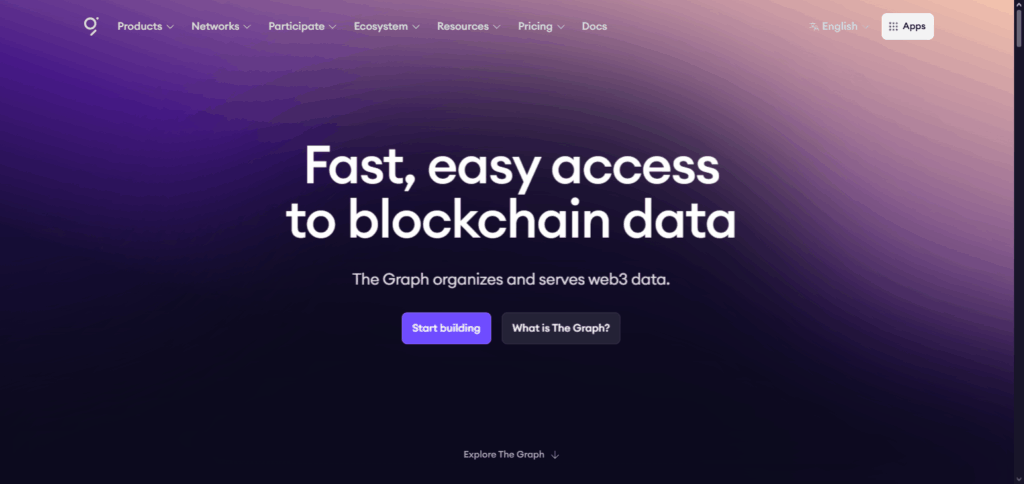
By linking these subgraphs to AI, The Graph broadens the data window for every dApp. Its Inference and Agent services let models ask and answer blockchain questions in real time. Because the indexing sits on a network, clear records and fast lookups stay open to everyone.
10. Akash Network (AKT)
Akash Network turns spare servers into a global cloud you can call without permission. Developers lease GPU power as needed, so machine-learning jobs stretch beyond single workstations.
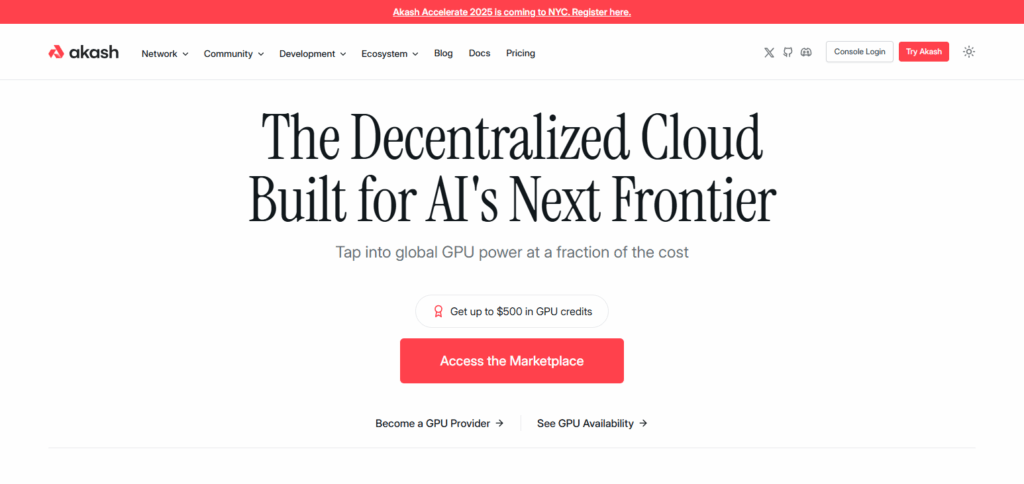
Payments happen in the AKT token, keeping costs down and fees predictable. Jobs go to the lowest bidder through a reverse auction, and prices drop when demand spikes.
An open, peer-to-peer grid protects data and identity, unlike old centralized clouds. By putting computing back in public hands, Akash reshapes the future of AI hosting.
Conclusion
The European Union is quickly becoming a center for decentralized artificial intelligence. Projects such as SingularityNET, Fetch.ai, and Ocean Protocol focus on building ethical, privacy-minded, and scalable systems.
Supported by solid research and rules that match EU law, these platforms are reshaping the regions AI backbone.
With partnerships like ASI and tools such as The Graph and Akash, Europe is ready to drive the next wave of smart, decentralized technology.


